How Blair Enns Built a Luxury Expertise Brand
He has generated $1 million in net revenue with one book, which is packaged and sold in an interesting, unconventional way. Another book is an evergreen bestseller with 100,000+ copies sold. And he co-hosts one of the biggest podcasts in his niche.
Blair’s impact on a niche is difficult to rival.
But I’d argue, from a 1,000 ft view, his production cadence is consistent rather than prolific.
At present, he posts a public email once a week and co-hosts a podcast every other week. He’s published a book every 6(ish) years.
In a world where "thought leaders" pump out daily content, Blair has built something entirely different through strategic scarcity.
That’s not to say he doesn’t make a lot of material. He makes and publishes stuff daily; it’s just that we don’t see it outside his close circle and customer base.
He’s like an elite comedian who only releases a Netflix Special every few years.
The work leading up to that Special is an act of making a lot, filtering through close circles, listening to what resonates, publishing to a slightly bigger audience, repeating the process, then curating the gold that turns into an absolute smash hit.
As Carl Richards would say, “Less, but deeper.”
So how do you systematically apply this strategic curation to create exceptional work while making people eagerly anticipate what comes next?
Blair's journey reveals a counterintuitive truth about thought leadership...

A few years down the line, Blair studies for a business administration diploma at a community college and works a part-time job organising concerts and speaking events for the Student Association.
When he finishes school and sees a job for a PR firm, he thinks, “That’s a natural progression.”
He applies for the job, but doesn’t get it.
A few months later, the PR firm calls him back to tell him, “We’ve bought an ad agency. Would you like a job in advertising?” He accepts, thinking at some time he’d move over to the PR side of the business. That never happened (he fell in love with advertising).
Early on during his time with that agency, his boss says to him, “Hey, you seem to be fearless. I’m going to put you in charge of new business.”
"I'm 22 years old, I barely know what I'm doing and he puts me in charge of new business. I didn't light it up per se, but I got some early wins and learned some tricks."
- Blair Enns
Source: Blair Enns on The Agency Collective
As Blair and his wife, Colette, were about to have their first baby, Blair’s parents decided to sell the cottage to finance an early retirement. They asked him if he wanted to buy the place, but he couldn’t afford it.
He loved going out to this place in the woods, and now it was no longer available to him. That got him thinking; if he couldn’t afford to have two homes, he might as well live where he wanted to live, which was in nature (and remote), not the city.
He pulled out a map of British Columbia (the only ‘nature’ he knew) and started circling small towns.
He and Colette took a one week vacation with their 9-week-old son. They drove across the country to visit these places and arrive at a beautiful town called Nelson. But, the town had a population of 10,000, which was bigger than he was looking for. So, he drives along the lake from Nelson until civilisation disappears in the rear view mirror. He decides, “Whatever is at the end of this road is home.”
They arrive at Kaslo and Blair tells himself, “This is it.”
Blair returns home and tells friends of his plans to move to this remote village. Colette stops him to say, “We’re not going anywhere. I’m having babies. You’re going back to work.”
So he goes back to work. Three years pass, then he gets a job offer in a location halfway between where he lived and Kaslo. Colette agrees to move (halfway). So, Blair tells himself, “Great, I’m halfway there!”
But he finds a new job with a boss he does like. At this point though, Colette agrees, “Why don’t we just move to Kaslo?”
Upon starting this role leading business development, he and his boss agree that Blair will work with him for 12 months, after which time, Blair tells him, “I’m going to move to the woods and do this consulting thing.”
Early in the role, Blair and his boss are in a business call together:
“I always hated being in this position in a sale where I was just one in a sea of many and the client had all the power, which they used to push me around. I remember when the president of the firm and I had a meeting with a prospective client.
At the end of the meeting, the client said, ‘Okay, you guys seem great. Why don’t you come back with some ideas on how you can help us?’ He wanted some concepts and I had heard that type of request too many times.
I said, ‘No, we never pitch.’
After the meeting, my boss said to me, ‘Hey, I don’t mind this approach you’re taking. Just let me know in advance.’ So I started pushing back without much of a methodology for how, but I fumbled my way through some successes.”
- Blair Enns
Source: Blair Enns on The Agency Collective
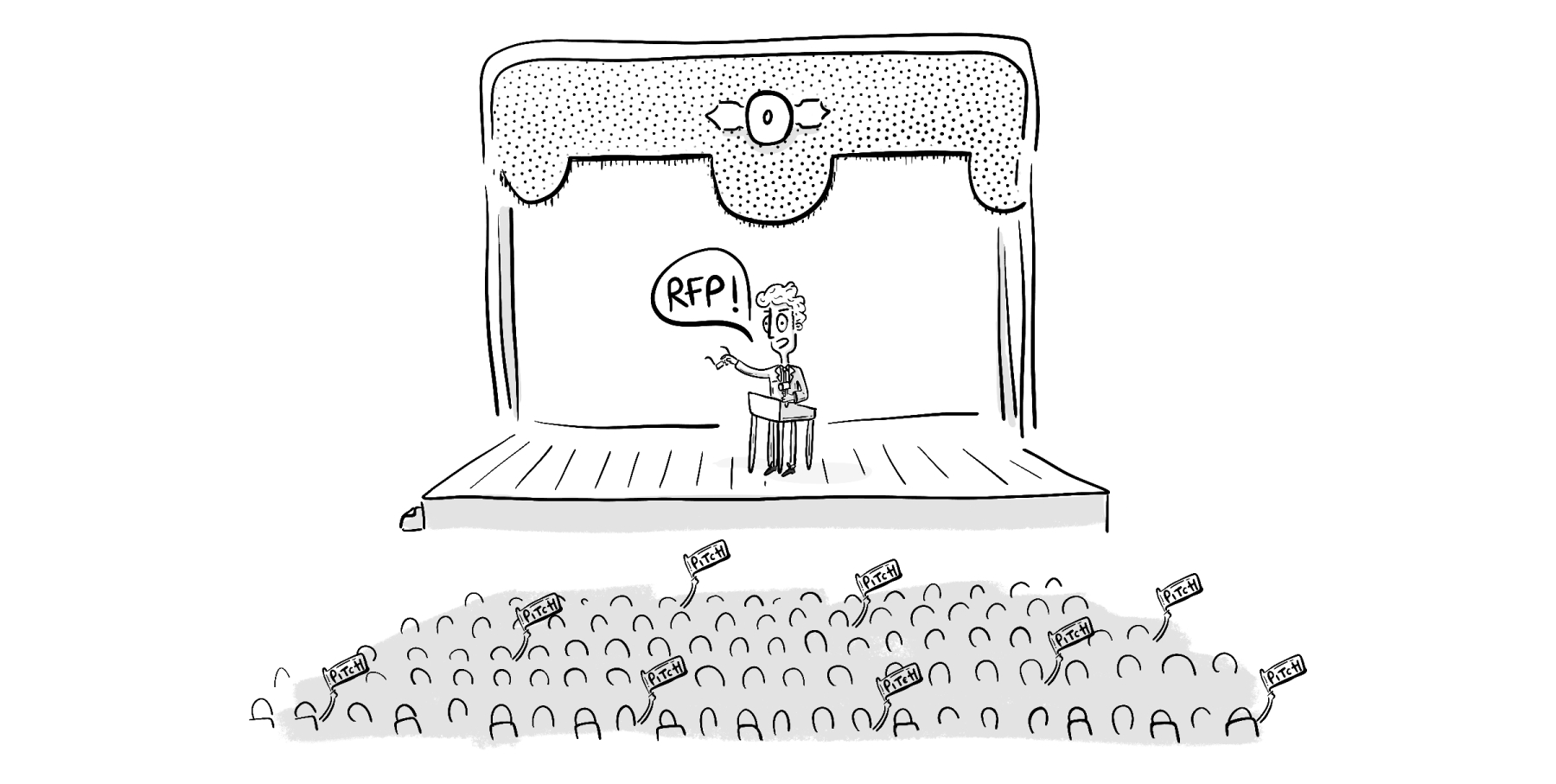
Around the same time, Blair’s boss signs him up for a sales training programme.
Blair thought it was great. Up to this point, he hadn’t received any formal sales training.
A woman called Pauline O’Malley led the training.
"When I went through the training, I just thought, this is brilliant. We don't do this basic sales stuff. And I don't mean to disparage her content – it was more than that. But even the basic sales skills and procedures, we're not taught those in the agency world."
- Blair Enns
Source: My Interview with Blair Enns
The boss asks him, “While you’re building your consulting practice, why don’t you just sell for me remotely from wherever it is you’re going?”
That gives Blair the financial security (for the next 12 months) to move to Kaslo and start his own consulting firm.

So, when he launches his consulting practice in 2002, he starts writing an approach. As he puts it, “I think through my fingers.”
He also contacted Pauline O’Malley (who ran the sales training course he attended) and asked her whether he could licence some of her material for a book he was writing. She agreed:
“The entire system of selling was in the book. Everything from how to position your firm through to the sales interaction. Pauline had this model she used that I licensed, which was a specific way to think about the stages in the sale. On top of that, I added a bunch of general, somewhat obvious material, but not obvious to those in the creative professions. Things like positioning, lead generation, navigating the conversation, constructing proposals, etc. It was soup to nuts.”
- Blair Enns
Source: My Interview with Blair Enns
“I wrote everything I knew about new business from this point of view and ended up with a book that was self-published called the Win Without Pitching Manual, which I sold for $995 a copy.”
- Blair Enns
Source: Blair Enns on Design Domination Podcast
He discovered the Second Wind Network, which had a list of agency members along with the names of their respective presidents and email addresses.
He sent 30 emails promoting the book and received 15 replies with an order.
"I was lucky to start my business in the early days of the Internet, where my response rates were 70%. There weren't a lot of people doing what I was. Or if there were, they were really difficult to find. Behind every successful business there's a whole bunch of luck – my timing was perfect."
- Blair Enns
Source: Blair Enns on The Agency Collective

From a positioning perspective, let’s reflect on what Blair did here…
“You choose a focus, claim expertise, and put your flag in the ground with that claim. But the claim is just the starting point. Make the claim before you're perfectly comfortable making it. It can be aspirational, and recognize that the act of making the claim will sharpen your focus to build the missing skills, capabilities, and processes like nothing else.”
- Blair Enns
Source: Blair Enns on The Futur
That was a bold claim; “I’m going to help you win without pitching.” In a market of clients accustomed to making unreasonable demands in the sales process, I’m going to help you decline those demands and still win the work.
He makes the claim before he’s ready to truly make it, which encourages him to go write the methodologies and think around his positioning.
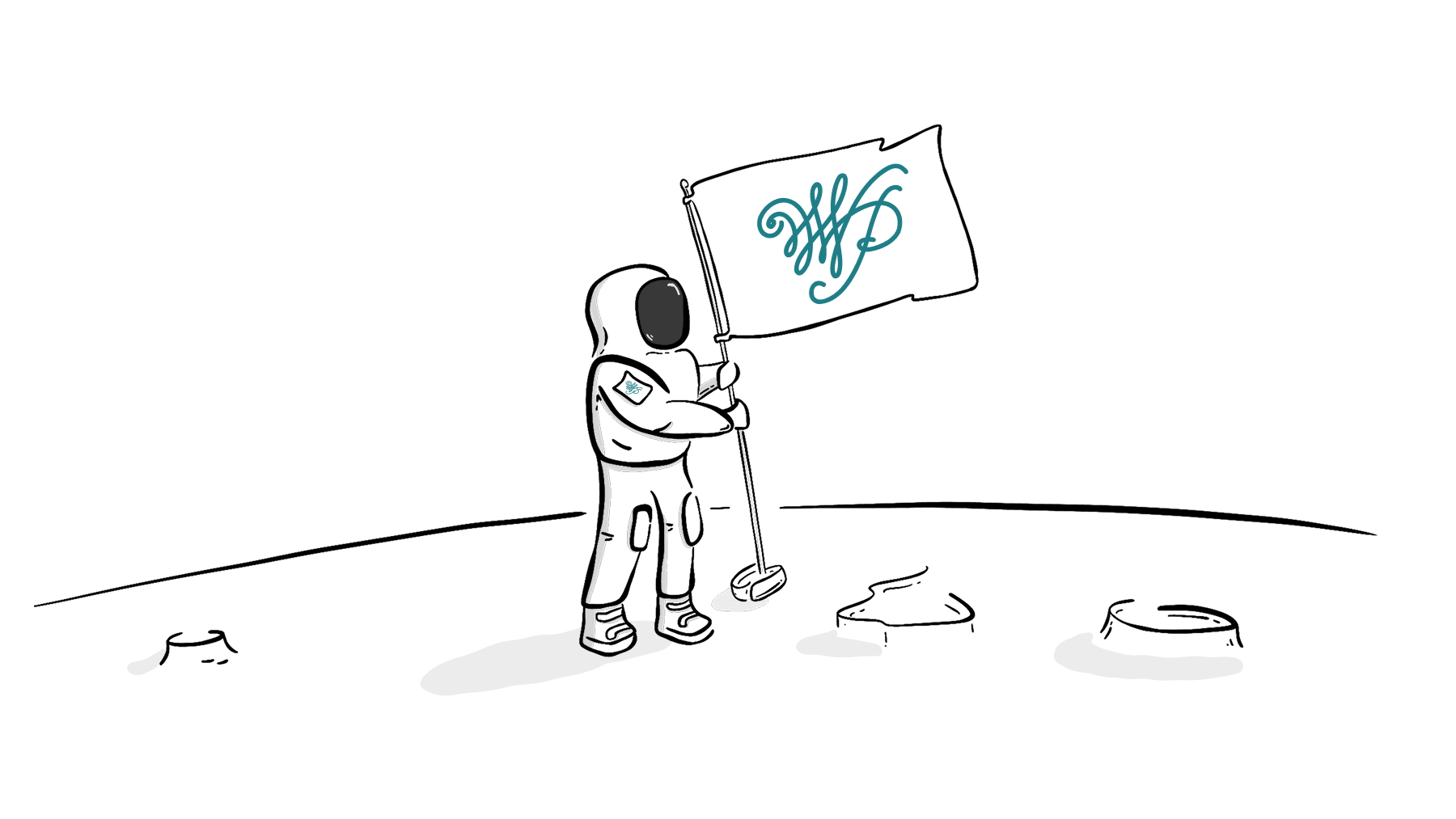

How did he build that audience?
First, he starts writing emails to develop and share his thinking:
"You don't know what you think until you write about it. Then once you're writing on something, all these other doors open that you could go down. You think to yourself, 'Oh, there's a good idea. I should come back to that.' If you don't make those notes along the trail, you'll forget they're there."
- Blair Enns
Source: Blair Enns with Anneli Hansson
“I was always uncomfortable with purchasing lists, though I don't know that you should be. I think it depends on how you use the list, how you introduce yourself to the list, and the value that you provide to the list. All of which is also a function of the quality of that list.”
- Blair Enns
Source: My Interview with Blair Enns
“I did a lot of speaking engagements. I identified all the stages I thought I needed to be on and slowly checked them off the list – it took years. So a speaking engagement leads to another speaking engagement leads to another.”
- Blair Enns
Source: My Interview with Blair Enns
Blair checks out David’s website and thinks, “Oh, he’s really smart!” He also notices that he David runs a conference called Mind Your Own Business. Blair tells himself, “I need to speak at that conference.”
Blair sends David an introduction with something along the lines of, “Hey, I’m just starting out. Here’s what I do. Here’s my website.” Of course, the website hosts the thinking he’s been sharing since launching The Win Without Pitching Manual.
David replies, “That’s really interesting. Do you want to speak at my conference?”
“I won the school oratory competition school-wide when I was in 7th grade. My talk was on advertising, so I was predestined to go into the advertising field and do public speaking. I had done public speaking before, but not under the banner of my new Win Without Pitching business. That was my first talk.”
- Blair Enns
Source: My Interview with Blair Enns
“I get this email from David C. Baker titled, 'Oops'. He said, ‘Hey, 2 days from now I’m doing a new business seminar for 20 agency owners in Nashville and I’m in the hospital with a kidney stone. What are the chances you could fly down here and do this for me?’
I flew down there and helped him out. He would leave the hospital for a few hours at a time to make sure I wasn’t destroying his good standing with clients.
The next year he said, ‘Why don’t we do an event together?’ We called it the New Business Summit and did it every year for 10 years. There were around 50 people in the audience when it first started, and by the time we shut it down, we had around 130.”
- Blair Enns
Source: My Interview with Blair Enns
“David introduced me to a bunch of people. Even though my talk in that first year was pretty bad, a couple people did hire me. He invited me back a couple years later and the same thing happened. I became well known in that community of small firms and many subsequently hired me over the years.”
- Blair Enns
Source: My Interview with Blair Enns
Audience members at the speaking engagements subsequently sign up for his email, a few become clients, and the majority continue to read his free content.
For these people who aren’t yet ready to become clients, the next step, as Blair puts it, is “to pay a little bit of money to go deeper into these topics.”
"Those people willing to part with some money are more likely to pay you for higher value stuff. So it's a great feeder product. And those that don't buy that product that is productized and delivered at scale are far less likely to hire you for your more valuable services."
- Blair Enns
Source: Blair Enns on Ditching Hourly
The revenue from these Webcasts was critical in between clients or during a downturn in the market.
Here’s more on the format:
- He’d pick one topic that he covered in The Win Without Pitching Manual
- Then, he’d go deep into it for 35 to 40 minutes and take questions for around 20 minutes
“I always went too long. I tried to cover too much material, didn’t leave enough time for Q&A.”
- Blair Enns
Source: My Interview with Blair Enns
"The new version of the Win Without Pitching Webcast is going to be called The Conversation. It's the old version, inverted: A 15-minute lesson on a narrow piece of content from The Four Conversations, followed by a 60-minute discussion to follow. The value is in the conversation that happens around the content."
- Blair Enns
Source: My Interview with Blair Enns
"With the Win Without Pitching webcast, we provided access to this massive library, but that can become overwhelming. People can't possibly watch all of these videos so they feel like they're paying for something they're not using. As a result, your churn goes up."
- Blair Enns
Source: My Interview with Blair Enns

This aligns with something Ryan Deiss told me around the Netflix model in B2B – It doesn’t work.
Customers in our space don't actually want an archive of your material. We're drowning in content, and when you present customers with a library, of which they'll consume a fraction, at some point, they develop the perception that they're paying for material that they're not using.
By throwing everything in, you devalue the material they actually came for:
"Your temptation, and I’ve gone through different iterations of this, is just to jam more value in there. But your churn will go up, your retention will go down.”
- Ryan Deiss

In December 2008, he released a blog post with 12 proclamations for the New Year.
This blog post takes on a ‘manifesto-ish’ tone, inspired by the writing styles of Confucius and Nietzsche, their “aphoristic writing style” and “short, pithy truths.”
Blair says, “I was the most nervous I had ever been about publishing content.”
He hits publish and immediately gets this sense that the post was a mistake.
But that sense quickly dissipates as the feedback starts trickling in.
“People were telling me, I’ve printed that out and mounted it on my wall.”
- Blair Enns
Source: Blair Enns on 2Bobs

This pattern comes up regularly in my research of other Undisputed Authorities. They publish a blog post or series of tweets, the material strikes a nerve with the market, the author subsequently recognises that they’re onto something, then they expand on that shorter form content into a coherent, structured body of work (a book).
For example, take Austin Kleon and Steal Like An Artist, which has sold more than 2 million copies:
“Steal Like An Artist was literally just a series of blog posts called, 25 quotes to help you steal like an artist. I was just collecting all these quotes by artists I admired who were using the word steal, and I was just sort of, this is really weird and interesting to me.”
- Austin Kleon
Source: Austin Kleon on The Futur
He’d already written the Win Without Pitching Manual, but he wanted to create a book that was more accessible and less of a ‘how to.’ Now, after six years of writing and speaking on the subject of winning without pitching, he was confident on the formulation of his thinking and the tone of his voice.
But what does an ideology book do that a how-to doesn’t?
"I always say that people will come for the thought leadership, but they'll hire you for the ideology.
And you're looking for one of two reactions to the ideology:
Number one, we are ideologically aligned. We think about these things the same way. You are my guy or gal.
Number two, 'I've never thought of it that way before. That's interesting.' You convert people to your ideological point of view."
- Blair Enns
Source: Blair Enns on 2Bobs
“I took a book that was the right thickness, then I cut it down to what I thought was the right size. I reverse engineered the word count from there.
Luckily it arrived at around 24,000 words. I could have made the book a little bit longer, a little bit shorter, but it just rested at 24,000. That gave me the freedom to write less than the standard 50 or 60,000 word count that they talk about for a business book.”
- Blair Enns
Source: Blair Enns on 2Bobs

It’s as relevant today as it was in 2010.
If the prospect chooses not to read the book (or didn’t like it), they were never going to become a customer. Blair and his team subsequently save themselves a lot of wasted time on dead-end prospect calls.
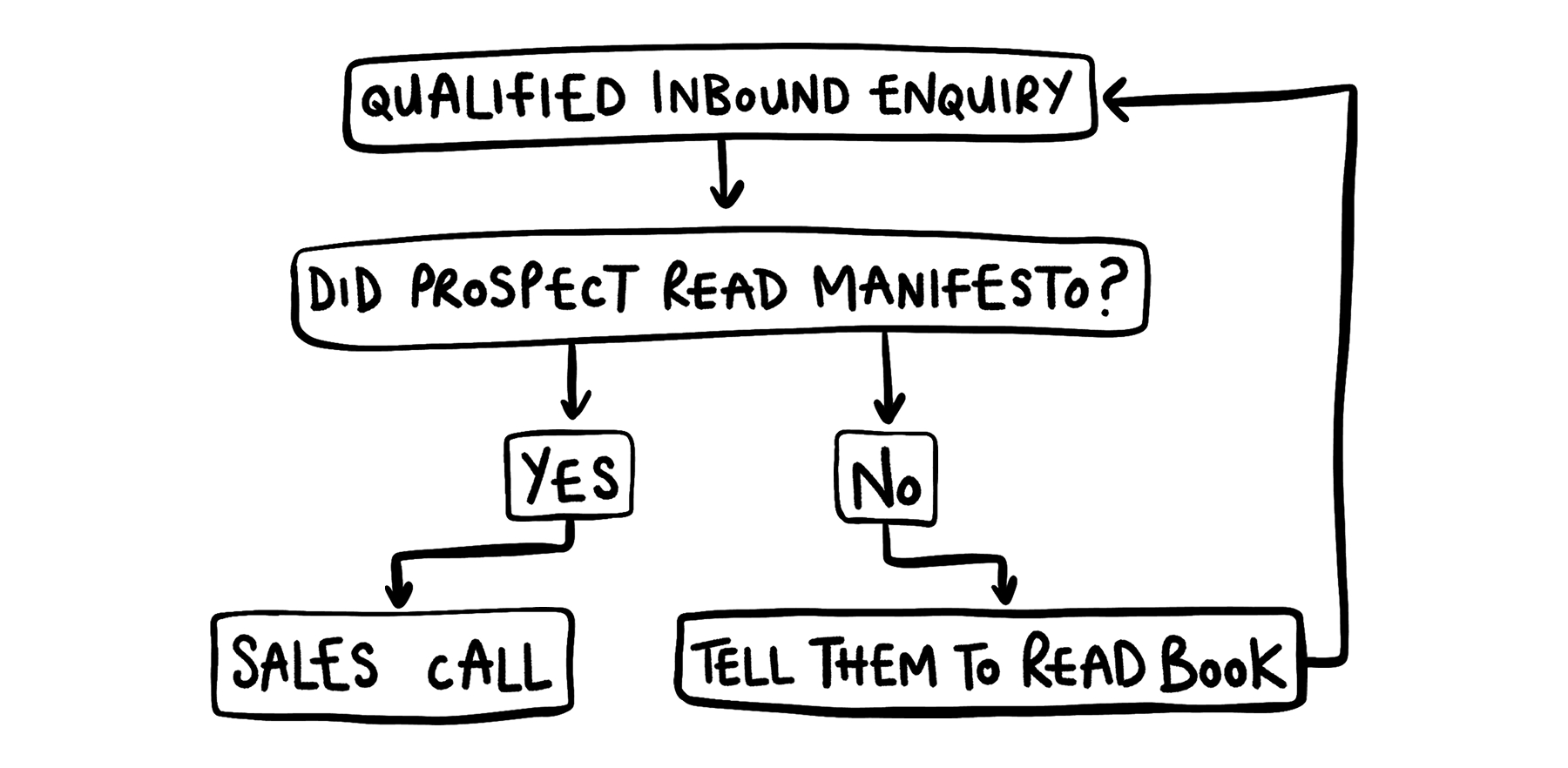
"From a sales advantage point of view, there's a lot to be said for having a polarizing ideology, putting it out into the world, and letting the market select based on, 'I'm either ideologically aligned or I'm not'."
- Blair Enns
Source: My Interview with Blair Enns
"It's done its job in getting a reach out there, of helping people, of getting us known and driving leads.
It's unexpectedly done a job in actually generating revenue.
So it's good marketing that does good work that actually makes money rather than costs money."
- Blair Enns
Source: My Interview with Blair Enns

“I had pushed the independent consulting model as far as I could go. In 2012, the last year as a consultant, I got sick four times on three continents. Not serious, but just run down. The last one in November, I was flat on my back in bed with pneumonia for two weeks. I thought, okay, it’s time to make the shift. This business model is killing me.”
- Blair Enns
Source: Blair Enns on Consulting Success Podcast
In his research, he discovered Ron Baker and value-based pricing, and came to the conclusion that he had been making a ‘classic mistake.’
“It became clear to me that there are customized services businesses, productized services businesses, and product businesses as well. In a customized services business, every engagement should be a blank slate of opportunity. It should be a creative act.”
- Blair Enns
Source: Blair Enns on The Agency Collective
Now, he’d come to the realisation that if he was going to grow his business, he needed to go to one end of the spectrum. He’d either embrace the fact that he had a customised business, only work with a handful of clients, then price based on the value created. Or, he’d pursue scale and sell productised services with little to no customisation. That second approach would involve hiring people, building training programmes and products, and selling them at set prices.
With a young family, based out of a remote corner of Canada, he chose the latter:
"I chose to productize because I felt I'd already done customized services. Also, it's really hard for me to get anywhere from where I live. If something came up and they needed me to be on site, it's not easy for me to get on site. It's as easy for me to get to London as it is to get to most places in North America."
- Blair Enns
Source: Blair Enns on The Agency Collective

Blair has since slightly changed his perspective on a couple of points above.
Firstly, he's introduced the distinction of standardised delivery and standardised pricing.
According to Blair, “The most lucrative business models for professional firms appears to be a combination of standardized delivery (productized services) and customized pricing (price the client).”
So, the firm or consultant develops a process (or processes) for consistently delivering results, but they don’t stick a price label on the service. They price each client according to the value delivered.
Secondly, the ceiling of potential for a consulting business model is significantly higher than the $350,000 he believed it was back in 2013:
“In hindsight it's clear to me I could have easily crossed the $1m threshold primarily though changes to my pricing model, without pursuing scale.”
- Blair Enns
Source: My Interview with Blair Enns
So he just kept buying book after book on the subject, taking what he could from each, then applying what he learned.
One day a friend tells him, “You should write a book on pricing.” Blair replies, “There’s a lot of great books [already] written on pricing.” His friend replies, “Your clients are never going to read those books.”
Blair took the advice and got to work writing a book on value-based pricing for creative firms, Pricing Creativity. It came in a three-ring binder, and, interestingly, he applied value-based pricing to the sale of the book. He gave customers three options:
- An ebook ($100)
- A three-ring binder plus ebook ($199)
- A 5-part video series with the three-ring binder and ebook ($320)
"I priced it this way for a few different reasons. One of our core values at Win Without Pitching is to lead by example. As I was writing the book, it occurred to me that I was unaware of any book on value-based pricing that was using the principles in the book to price the book. I wanted to be the first to do that.
I felt strongly that the amount of value this book would create in their world was enormous. I'd done some rough math and conservatively felt that the book would help create over $100 million a year in new excess profits for the global creative community. I thought, 'If I'm going to help to create $100 million a year in new profit, what's fair compensation for me?'
I actually think charging $25 or $40 for the book would have devalued what was inside the book and would have actually had a negative impact on the effect. The more you pay for something, the more you value it."
- Blair Enns
Source: Blair Enns on Modern Sales - B2B Selling Podcast


This is a good point to highlight the three different ways to produce thought leadership content, of which Blair uses two.
All require insight derived from data.
The first type is data derived from personal experience. For Blair, that was The Win Without Pitching Manifesto. Blair had spent eight years working with creative firms, helping them win business without submitting to the formalities of a pitch. He did no research for that book. The insights were derived from his personal experiences and expertise on the subject – the patterns he’d noticed in the field.
The second type of data is primary. As far as I’m aware, Blair hasn’t created any significant thought leadership using primary research, so we’ll use David C. Baker as an example. David’s firm, Punctuation, works with agency owners sell their firms and buyers buy them. He’s worked with over 200 firms at this point, and in doing so, has built a repository of unique, proprietary data on the intricacies of buying and selling a firm – hard numbers, which inform unique thought leadership.
The third type of data is secondary, which is what Pricing Creativity is built on. Blair conducts heavy research on pricing using secondary data (books), then translates that data and applies it to a new field – creative firms.
"I'm always worried about taking in too much information. Living in a remote mountain village in the middle of British Columbia is helpful. I went without television for over 20 years. I started cutting off sources of information and stimulus because I needed more time to think. I've always been careful about the information that comes in. I don't absorb a lot of information from other people in the space that I serve. Even David C. Baker's weekly email, I might only read one in six of his posts.
I sample information of what other people in my space are doing. I'll flip through to glean ideas. But I do not want to deeply absorb somebody else's content. All of our thought leadership is obviously informed by others and multiple sources, but you have to be careful about the input because it affects the output."
- Blair Enns
Source: Blair Enns with Anneli Hansson
Notice that none of the research for any thought leadership content involves heavy consumption of material from within his own field. There’s value in knowing what your peers are doing, but if you look too closely, you end up regurgitating ideas that have already been presented to your target customer (which leads to vanilla content that gets ignored).
So, if you’re going to do research, either collect proprietary data or translate ideas and stories from other fields.

But let’s reverse back a few years.
He had experienced a handful of transformative moments in his entrepreneurial career. The first was launching as a consultant with Win Without Pitching and the corresponding Win Without Pitching Manual. The second, arguably, was the invite to speak at Mind Your Own Business with David C. Baker. That led to David and Blair launching a new, annual event, The New Business Summit, that they’d co-host together.
By 2015, after ten years of hosting the event, it was becoming stale for Blair:
"My material had evolved, but because I had a co-presenter, we had our lanes and I couldn't evolve into his. It wasn't a horrible thing, but a voice said to me, 'You're just standing up there saying the same thing you did last year and the year before. This is dangerous for you to get into this rut'."
- Blair Enns
Source: My Interview with Blair Enns
So Blair suggests the idea, and Marcus, who was producing The New Business Summit, already knew everything about audio editing. There were few obstacles for them to get started.
They record the first episodes in 2015, but they don’t release them until 2017.
“If there is an easier, funner way to produce a large amount of quality content, I don’t know what it is.”
- Blair Enns
Source: Blair Enns, How to Cheat Content Marketing
They didn’t stop at 50 episodes. Since then, they’ve recorded hundreds.
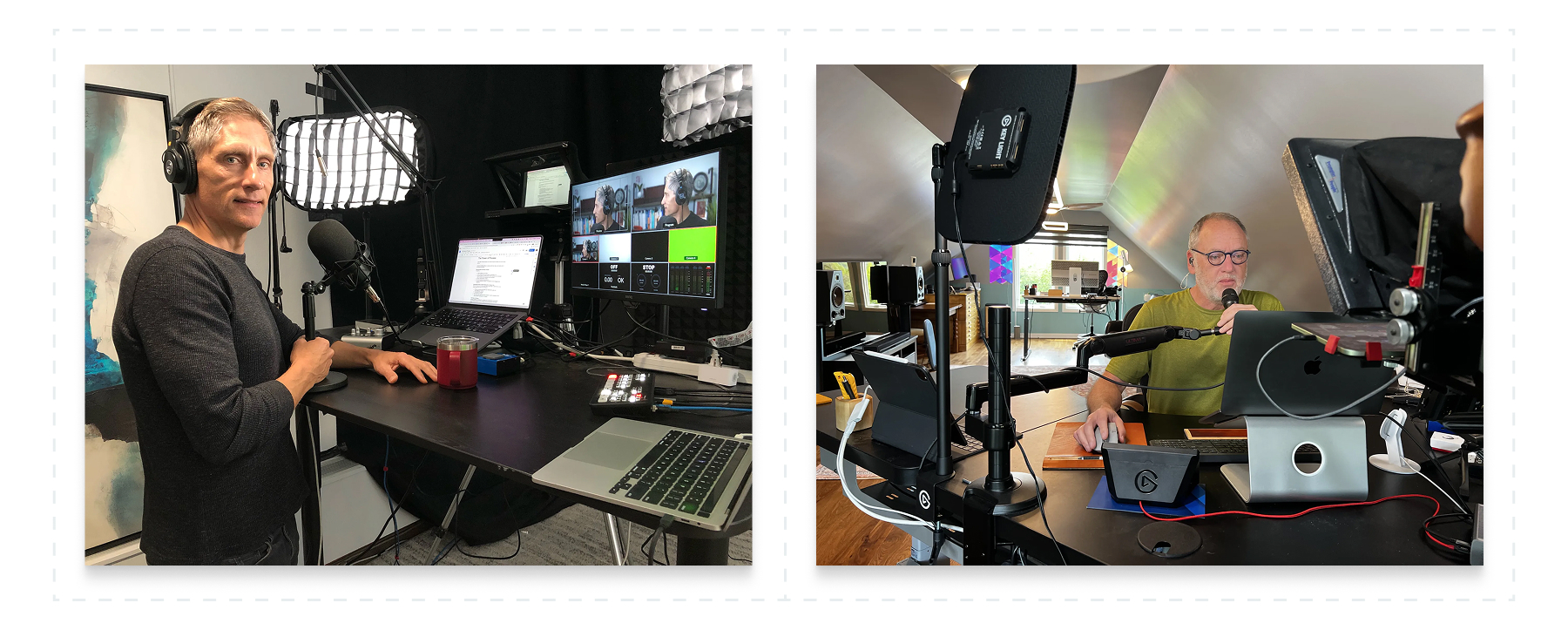
Feedback is great, downloads have been growing since the beginning, and according to David, “We can’t have a new business conversation without somebody bringing it up.”
“It was Blair’s idea to do it, and I kind of went along with it because I like him; we’re friends. I didn’t think much would come of it, but I have just been blown away at how it has impacted my business.”
- David C. Baker
Source: David C. Baker on Smart Business Revolution Podcast

Deconstructing one particular piece of content or format to look for signs of success is a dangerous game, but there are a few areas we can safely analyse and draw conclusions from.
Both David and Blair have said that the key to producing a podcast as a duo was that they both know each other really well. They’re good friends, and there was chemistry from day one.
Another thing to note is that they prioritise writing, first and foremost, which is essential to developing their thinking that they share on the podcast. Every second or third blog post gets turned into a podcast. The audio material isn’t off the cuff and they curate only the best writing for the podcast.
He makes a lot, publishes a little.
Blair writes a daily email to his private list – The Win Without Pitching Academy. Once you go through their training, you get access to the Academy and mobile app.
He delivers short, 200-300 word posts. That’s the making a lot aspect.
He’s curating the best ideas, turning them into public blog posts or LinkedIn posts.
It’s like the comedian sharing his material amongst his peers. The material that gets the right response from peers passes through to a small audience, subsequently filtering again for the stuff that resonates. Then, those pieces are constructed together to form a Comedy Special.
I don’t know if the podcast is the equivalent of the Special. The book is probably the equivalent, but there’s a ladder of curation, and the podcast is towards the top.
My guess is that’s why the material resonates so deeply. It’s gone through a thorough filtering process.
Then the very best of those get turned into a podcast.
This pattern is consistent amongst elite artists in every field.
They make a lot, publish a little (as James Clear calls it).

The book wasn’t designed to be a how-to – it’s about ideology. But for many years, Blair had the idea of publishing a framework book, which is essentially, “If you were inspired by The Manifesto, here’s how to put these principles in action.”
In 2014, four years after publishing the Manifesto, Blair got to work on the framework book that would capture the essence of the process he taught students in his Win Without Pitching programme (originally titled, Selling Expertise).
He took ten years to write the book, which he published in 2024. He subsequently changed the title to The Four Conversations:
“I had a lot of people tell me it should be Selling Expertise because it's a more SEO friendly title, but I just refuse to write for SEO. Anybody could write Selling Expertise. I’m the only one who could write the Four Conversations: A New Model for Selling Expertise.”
- Blair Enns
Source: Blair Enns on 2Bobs

"Somebody is going to buy the book, and I'm not the first author/owner of a training program to grapple with this question. They don't need to do the training. And on some level it may cannibalize training. But really, when somebody asks, 'What's the difference between the book and the training?' My answer is, 'It's the difference between understanding and knowing'."
- Blair Enns
Source: My Interview with Blair Enns

I don’t see potential cannibalisation where Blair does.
It's unlikely that someone who buys the $30 book and then DIY was ever going to by your $4,000 training programme.
What’s more likely is a bunch of DIY folk will evangelise your approach (if it resonates), buy the book, share the book, and engage with your content online, as happened with April Dunford. That builds the authorities’ standing in the space, which gives them the opportunity to speak on bigger stages and podcasts.
The people who are likely to buy the $4,000+ training programme attend those events and listen to those podcasts. They subsequently read the book, and then have the inclination and budget to pay for the training (because they want Blair and his team to help them practice and implement the framework).
“You priced The Four Conversations at $30. If Pricing Creativity was worth $320, is your framework worth 1/10 of that?”
His answer blew me away:
“I thought about it, that The Four Conversations could be priced at $1500. It could be priced at $2500, and it could contain some videos with it. I could have turned that into a self-directed course. But I've learned that the method by which you scale your business is the method by which you will commodify your offering. Turn your IP into a self-directed course, it just commodifies it.”
- Blair Enns
Source: My Interview with Blair Enns

Blair often talks about the three rungs of the lead generation ladder.
At the top, you have thought leadership. “The number one thing you can do is publish a bestselling book or a TED Talk (Not a TEDx).”
Essentially, paid exposure (ads, sponsorship, direct mail) is in the middle.
Outreach is at the bottom.
Blair has said of his own lead generation, “I’m really good at the stuff at the top, and as you move down the rungs, not so good.”
I’d argue that the decision to not be so good at the bottom two rungs and focus on the top is the foundation upon which his success has followed.
His focus has always been to produce groundbreaking, thought-provoking content. Because of this, you won’t find him in many places. He doesn’t post frequently on LinkedIn, or X, or any other social platform.
He and David publish a podcast episode once every other week. Blair sometimes sends an email weekly, sometimes less frequently.
Across the span of almost 25 years, he’s ‘only’ published four books. For some, that’s a lot, but amongst his peers, I’d say it isn’t.
He has built the ultimate luxury brand in his space. Everything he puts out is quality and relatively scarce.
And the stuff we truly value is scarce, so we hold onto it.
“In a capitalist economy, the market rewards things that are rare and valuable. Social media use is decidedly not rare or valuable.”
- Cal Newport
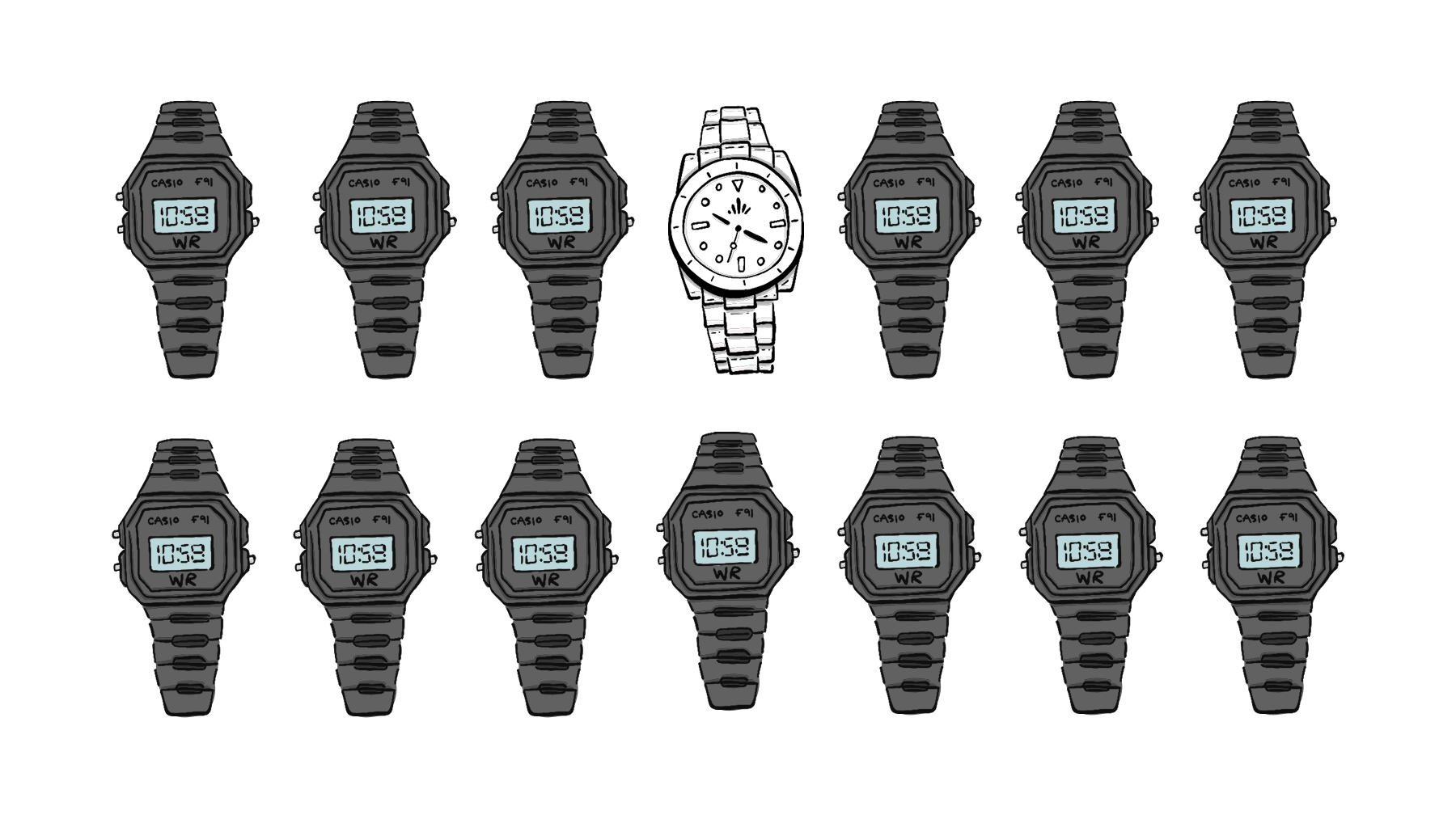
Rolex limits the supply of its products for a reason.
Blair does the same, and his books are beautiful, as are his words.
We aren’t exposed to average, never mind garbage thinking. He has filters in place, whether those are from his inner circle or his private email list.
Everything that comes out beyond those circles has been tested, resonated and distributed to the wider market.
“Christopher Nolan hasn’t made many movies (and has carefully kept his first student film hidden from view). If he puts his name on it, people pay attention.”
- Seth Godin
Relatively speaking, he makes a lot, publishes a little.
That exclusivity, luxury, and original thinking is present in everything Blair does and priced accordingly.
Like Christopher Nolan or Bruno Mars, they don't produce as often as their peers. But when they do, the world stops to buy, applaud and acknowledge them as the greatest in their field on the back of great work, not a lot of work.
Blair discovered this counterintuitive truth: you build authority through scarcity, not volume. By making a lot and publishing a little, by being strategically scarce rather than constantly available, he created consulting's first luxury brand.
In a world that rewards rare and valuable things, Blair Enns chose to be both.
Why do some experts become authorities while others stay invisible?
I've studied dozens of top consultants like David C. Baker and April Dunford and identified the patterns behind their success.
Get my free 10-part email series breaking down how they transitioned from invisible experts to Undisputed Authorities.
Note: With Blair Enns' permission, quotes have been edited to remove verbal fillers and improve readability while preserving meaning and voice.
